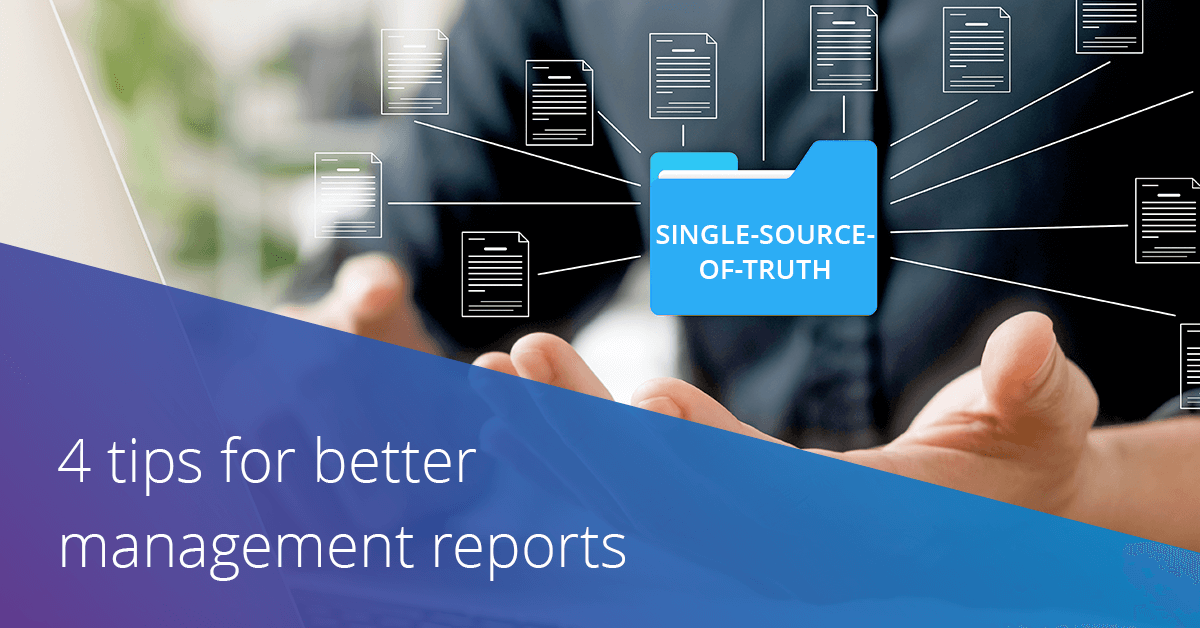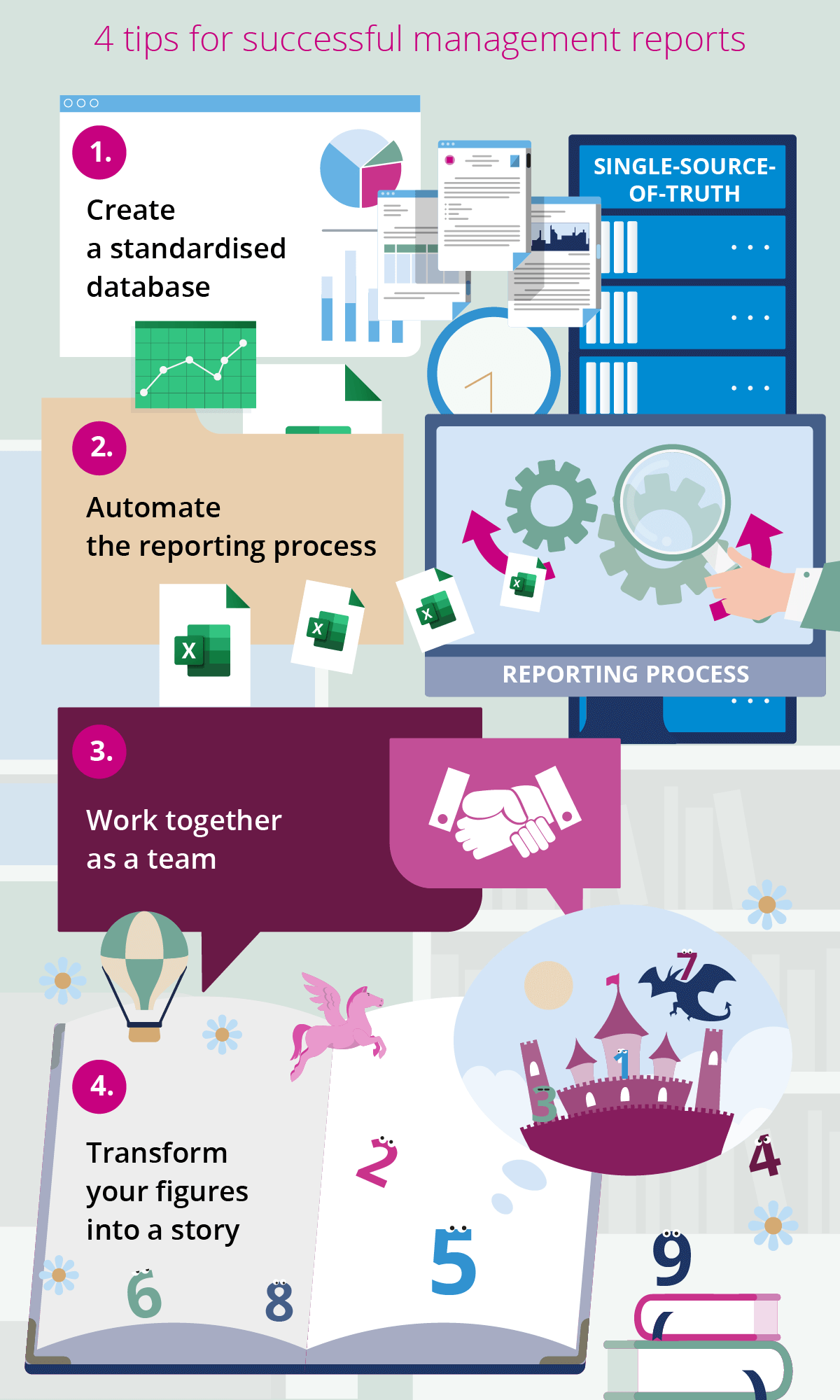To make important decisions in the right way, a company’s management team not only needs a good instinct, experience and people skills, but above all else sound, reliable data. That’s where management reports come in, which deliver the most relevant information to the decision-makers and leaders of an organisation so that they can determine strategically clever measures.
But what exactly makes a good management report? In what ways could many companies improve their reporting? This article provides a great overview of the topic and shares four tips to help you achieve efficient management reporting.
What are management reports in accounting?
When you go to the doctor’s for a checkup, they give you a kind of status report of your health: What are your cholesterol and blood sugar levels? How are your heart and lungs?
A management report is similar because it functions as a status report on how a company is faring. Only it doesn’t contain blood pressure values, but instead profit and loss statements, budgets, cash flow, employee productivity, customer profitability and so on. This information from both operational processes and the finance department should ideally be presented in such a way that decision-makers can easily understand it, identify trends, analyse data, align activities to the company’s overall goals and make well-founded decisions. In other words, a management report paves the way for implementing measures for the good of the company.
Why good management reports matter
Management reports are key to the success of a company. Decision-makers can use the data they contain to take well-informed steps toward saving on costs, investing in new projects, tapping into new markets or improving existing processes.
At the same time, they’re also an important tool for communicating with external stakeholders, for example investors, because they provide transparency, give shareholders the information they’re entitled to and lay the foundation for trust between the management board and its stakeholders.
Why Excel is more of a hindrance than a help in management reporting
Although Excel spreadsheets can be a useful tool, they’re not the best solution for management reporting. Cluttered tables that are difficult to navigate are not an effective means of presenting important information to decision-makers. However, many companies still use this method for their management reporting. That defeats the purpose because executives and top managers often only have a limited time window to analyse the reports. What they therefore need is an informative and clearly arranged document that displays the all-important key performance indicators (KPIs). Spreadsheets give them the exact opposite: a confusing jumble of information.
And that’s just one part of the problem – spreadsheets come with additional pitfalls. Executives need reliable, error-free management reports in order to make strategically important decisions, but reliability is the last thing they’ll get if their employees prepare the reports using self-built spreadsheets. Anyone who has ever contended with complex Excel tables will agree that it’s often hard to find a way through the maze of different versions, inconsistent data and multiple errors that have to be manually corrected (if they’re noticed in the first place).
How to write a Management Report
So, where’s best to start? What are the options and methods for preparing quicker, more transparent and more reliable management reports? We’ve put together four essential tips that will be sure to improve the quality of your reports.
1. Create a standardised database
Establishing a consistent and integrated database is the most important step in modern reporting – but it’s also the biggest challenge, given that many companies still rely on outdated and complex system environments and use all kinds of data sources. This leads to reduced data quality and availability. Finance teams then spend countless hours on manually correcting errors and validating data. A single source of truth for your financial data is a better alternative for generating your management reports. Combining your financial data into one central hub significantly reduces the time needed for reporting, while increasing data accuracy. As a result, finance teams can focus on deriving insights and specific measures from the data instead of manually removing avoidable errors or arguing about who is responsible for what.
2. Automate the reporting process
Coming back to Excel, we all know how time-consuming it is to manually update financial data from various sources, trawl through endless Excel spreadsheets, manually insert ad hoc corrections and check for consistency. The best way to leave all that behind is to automate the entire reporting workflow. By doing so, you’ll save time and money, because redundant, often manual process steps will become unnecessary due to the automation, and because the whole process can be managed better and more efficiently among everyone who is involved.
3. Work together as a team
Embrace collaboration. In an ideal reporting process, the CFO works together with the person in charge of the department delivering the figures. After all, the goal of every management reporting process is to gain detailed insights in order to implement suitable measures for steering the company in the right direction. In this respect, it is better to actively involve other departments in the reporting process so that they can provide key findings and explanations in case of discrepancies.
4. Transform your figures into a story
It’s a common misconception that management reporting is all about the quantity of data, in the sense of “the more, the better”. Far from it, though. The quality of the financial figures and how this data is contextualised and presented are much more important. Find the story behind the figures and tell it. Stories spread faster than numbers, and that’s exactly what you want: for the insights from the management reports to be well received, applied in the context of targeted corporate management and communicated to all stakeholders in the company. Your figures need to be transformed into stories in order to identify specific action areas and measures for your organisation.

